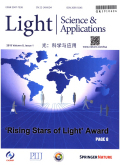- 钛学术文献服务平台 \
- 学术期刊 \
- 工业技术期刊 \
- 电工技术期刊 \
- 光:科学与应用(英文版)期刊 \
Genetically encoded BRET-activated photodynamic therapy for the treatment of deep-seated tumors
Genetically encoded BRET-activated photodynamic therapy for the treatment of deep-seated tumors
基本信息来源于合作网站,原文需代理用户跳转至来源网站获取
摘要:
Photodynamic therapy (PDT) is one of the most appealing photonic modalities for cancer treatment based on anticancer activity of light-induced photosensitizer-mediated reactive oxygen species (ROS), but a limited depth of light penetration into tissues does not make possible the treatment of deep-seated neoplasms and thus complicates its widespread clinical adoption. Here, we introduce the concept of genetically encoded bioluminescence resonance energy transfer (BRET)-activated PDT, which combines an internal light source and a photosensitizer (PS) in a single-genetic construct, which can be delivered to tumors seated at virtually unlimited depth and then triggered by the injection of a substrate to initiate their treatment. To illustrate the concept, we engineered genetic NanoLuc-miniSOG BRET pair, combining NanoLuc luciferase flashlight and phototoxic flavoprotein miniSOG, which generates ROS under luciferase-substrate injection. We prove the concept feasibility in mice bearing NanoLuc-miniSOG expressing tumor, followed by its elimination under the luciferase-substrate administration. Then, we demonstrate a targeted delivery of NanoLuc-miniSOG gene, via tumor-specific lentiviral particles, into a tumor, followed by its successful elimination, with tumor-growth inhibition (TGI) coefficient exceeding 67%, which confirms a great therapeutic potential of the proposed concept. In conclusion, this study provides proof-of-concept for deep-tissue"photodynamic"therapy without external light source that can be considered as an alternative for traditional PDT.

推荐文章
Deep web接口查询能力估计
查询接口
查询能力
Deep Web数据源自动分类
Deep Web
查询接口
朴素贝叶斯分类
Tourmaline activated persulfate for degradation of Sirius Türkis GL 01
Tourmaline
Persulfate oxidation
Direct azo dye
Ultrasound
Decolorization
一种Deep Web聚焦爬虫爬行策略
结构化Deep Web数据源
聚焦爬虫
决策树分类器
内容分析
关键词云
关键词热度
相关文献总数
(/次)
(/年)
文献信息
| 篇名 | Genetically encoded BRET-activated photodynamic therapy for the treatment of deep-seated tumors | ||
| 来源期刊 | 光:科学与应用(英文版) | 学科 | |
| 关键词 | |||
| 年,卷(期) | 2022,(3) | 所属期刊栏目 | Articles |
| 研究方向 | 页码范围 | 311-323 | |
| 页数 | 13页 | 分类号 | |
| 字数 | 语种 | 英文 | |
| DOI | |||
五维指标
引文网络
引文网络
二级参考文献 (0)
共引文献 (0)
参考文献 (0)
节点文献
引证文献 (0)
同被引文献 (0)
二级引证文献 (0)
2022(0)
- 参考文献(0)
- 二级参考文献(0)
- 引证文献(0)
- 二级引证文献(0)
引文网络交叉学科
相关学者/机构
期刊影响力
光:科学与应用(英文版)
主办单位:
中国科学院长春光学精密机械与物理研究所
出版周期:
双月刊
ISSN:
2095-5545
CN:
22-1404/O4
开本:
出版地:
吉林省长春市东南湖大路3888号
邮发代号:
创刊时间:
语种:
eng
出版文献量(篇)
762
总下载数(次)
0
总被引数(次)
112
期刊文献
相关文献
推荐文献

 免费查重
免费查重










